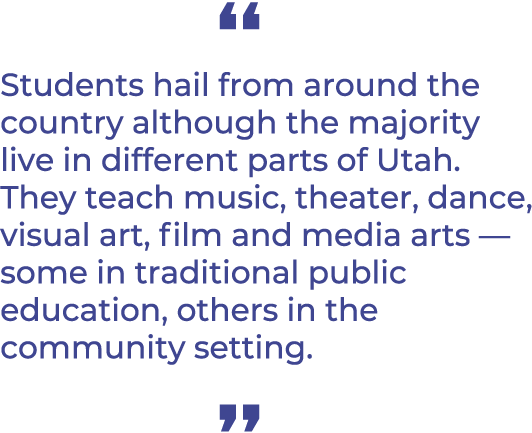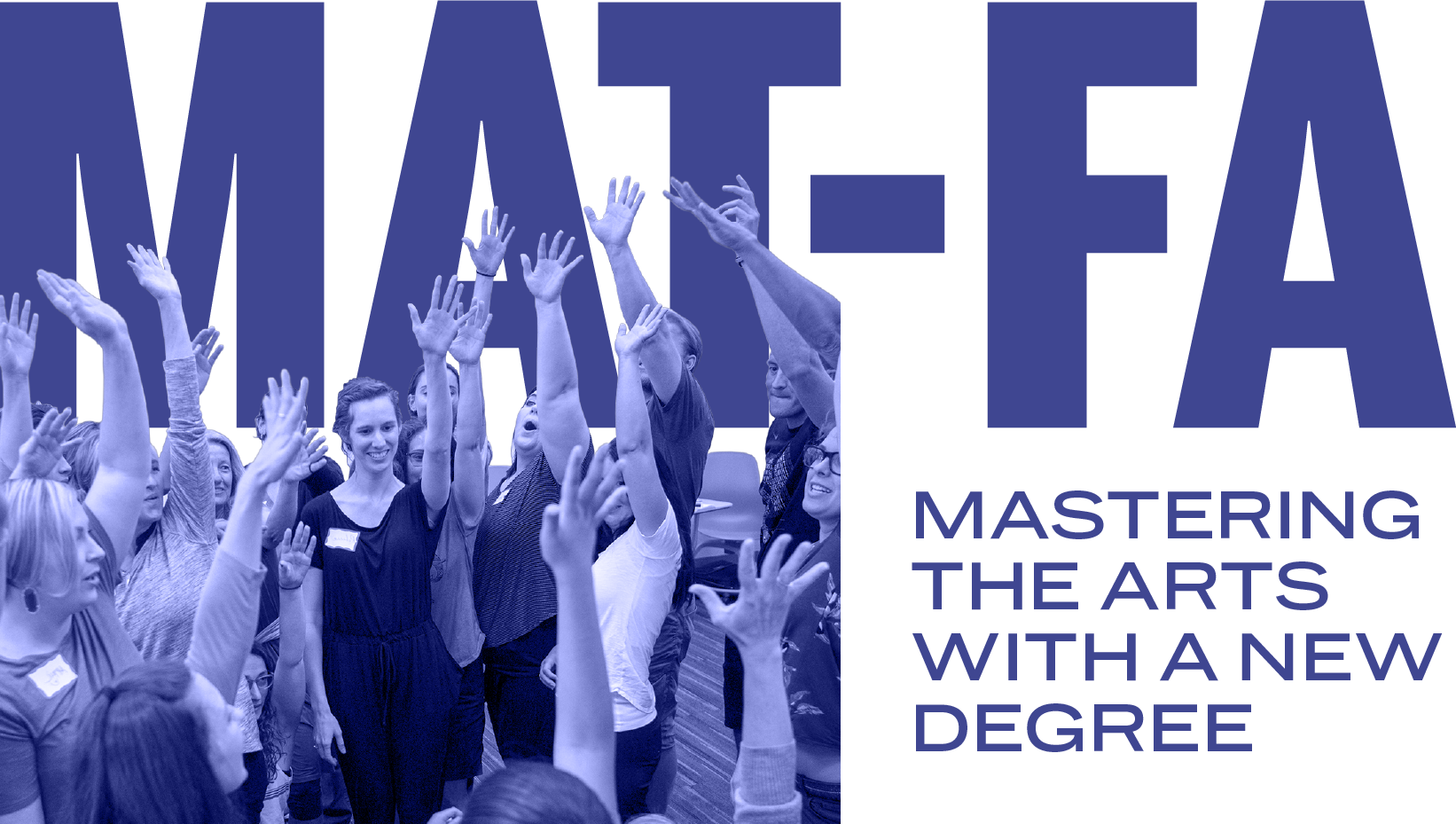The inaugural cohort of MAT-FA students creating devised participatory performance pieces in collaboration with young people from the Hartland Youth Center. (Photo: Eduardo Ayres Soares)
WRITTEN BY JULIA LYON
Georgiana Simpson wanted to take her teaching to a new level. So she enrolled in the new Master of Arts in Teaching with an emphasis in Fine Arts (MAT-FA) and felt her confidence build.
“The quality of individuals with whom I have worked, the professors, and my cohort have helped me grow exponentially as a teacher and an artist,” said the Whitehorse High School teacher.
The interdisciplinary degree, open to educators with or without teaching licenses who want to enhance their teaching skills in the arts, was recognized in 2019 as one of the best online master’s programs in the nation.
Ranked 11th by TheBestSchools.org, which grades schools based on academic caliber, faculty, accreditation, and liberal arts commitment, the online graduate degree is unique.
“The College of Fine Arts offers the only Master of Arts in teaching degree with an emphasis in Fine Arts in the country,” said Kelby McIntyre-Martinez, the Assistant Dean for Arts Education & Community Engagement. “We listened to our constituents and created something unique in terms of curricula and delivery.”
Launched in June 2018, the two-year degree program with its online hybrid format allows working educators to get a degree while continuing to teach. MAT-FA students spend two weeks on campus at the University of Utah for two summers and do the rest of the classes online.
Many of the students have been teaching for 8 to 10 years and have families, making it difficult to go to school full time.


A MAT-FA student conducts a math/visual arts integration lesson with a fourth grade student. (Photo: TWIG Media Lab)
“This MAT-FA degree makes it possible for Utahns and people across the country to bring all the arts together and to think about our field in new and profound ways,” the Assistant Dean said. “We want them to be challenged by multiple art forms, to think differently about their teaching practice, and to consider how student populations are changing.”
The MAT-FA came to life after years of surveying educators about what kind of program would best meet their needs. More than 200 local and national arts educators were interviewed. Many of those expressed interest in a master’s degree but said they could not quit their jobs to pursue an additional degree.
Students hail from around the country although the majority live in different parts of Utah. They teach music, theater, dance, visual art, film, and media arts — some in traditional public education, others in a community setting. A little more than a third are single parents.
Some are teachers who don’t specialize in any one arts discipline but who are passionate about bringing the arts into their classrooms. Students from certain western states pay reduced tuition rates.

MAT-FA students work alongside young people from the University of Utah’s Hartland Youth Center to implement arts based-teaching strategies as they create devised performance pieces during the program’s on-campus summer residency. (Sarah Knight)
The two residencies on campus are extremely focused. From 8 a.m. to 4 p.m., six days a week, the students meet with their cohort and attend courses on teaching strategies, participate in workshops with nationally-recognized artists, and go into the community to develop and implement arts-based lesson plans.
By coming together in the summer, the students establish deeper relationships that become more meaningful as they give each other feedback and complete online coursework throughout the rest of the year.
The goal is to focus on skills the graduates can bring to the classroom or the community.
“The MAT-FA offers practical, real world knowledge that is applicable to their everyday teaching experiences,” said Anne Dibble, the Fine Arts, MAT Program Administrator.
Faculty include professors from the School of Dance, School of Music, Department of Theatre, Department of Art & Art History, and the Department of Film & Media Arts.
The students are drawn to the program by the variety of expertise and the opportunity to work with accomplished faculty from across the College of Fine Arts.
While students engage in research and study theories underlying best practices in teaching, the curriculum requires students to go further as they apply diverse teaching methods both during the summer residencies and while taking online classes.
“Our faculty are leading the way in terms of generating and applying new arts education research,” said McIntyre- Martinez. “They’re bringing 21st century ideas to this program. MAT-FA students are being challenged in ways that are authentic and relevant to their specific communities.”
For Simpson, the art teacher in San Juan County, the degree has helped her “fill in the gaps” in her non-traditional teaching background.
And even though she lives in a remote rural community in Utah, the MAT-FA provides her with access to the same high-quality education as her more urban counterparts.
“The MAT-FA program presented a way to take my art teaching to the highest professional level,” she said. ■













